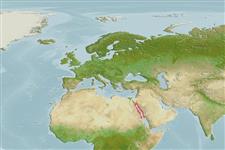Common names from other countries
>
Blenniiformes (Blennies) >
Blenniidae (Combtooth blennies) > Salariinae
Etymology: Ecsenius: Greek, exenios, -os, -on = uncontrolled, immoderate.
Environment: milieu / climate zone / depth range / distribution range
Ecologia
marinhas associadas(os) a recifes; intervalo de profundidade 10 - 37 m (Ref. 5296). Tropical
Western Indian Ocean: Red Sea and Gulf of Aqaba; south to Djetta, Saudi Arabia and Towartit Reef, Sudan.
Tamanho / Peso / Idade
Maturity: Lm ? range ? - ? cm
Max length : 5.5 cm TL macho/indeterminado; (Ref. 9710)
Descrição breve
Chaves de identificação | Morfologia | Morfometria
Espinhos dorsais (total) : 12 - 13; Raios dorsais moles (total) : 16 - 18; Espinhos anais: 2; Raios anais moles: 19 - 20; Vértebras: 34 - 37. Dorsal fin XII or XIII (rarely XII),16-18 (rarely 18), deeply notched between spinous and segmented ray sides. Anal fin II,19 or 20. Pectoral fin 13-15 (typically 14). Segmented caudal-fin rays 13. Vertebrae 10 or 11 (rarely 10) + 23-26 (typically 24 or 25) = 34-37 (rarely 34). Dentary
incisor teeth which includes anterior canine teeth very similar in appearance with incisors 46-57; posterior dentary canines 0 or 1 (rarely 0) on each side. Lateral line without pairs
of pores, terminating posteriorly at a point between verticals from dorsal-fin spines 8 and 10. With cirrus on posterior rim of anterior nostril; absent on anterior rim.
Adults occur in coral reefs. Secretive (Ref. 9710). Oviparous. Eggs are demersal and adhesive (Ref. 205), and are attached to the substrate via a filamentous, adhesive pad or pedestal (Ref. 94114). Larvae are planktonic, often found in shallow, coastal waters (Ref. 94114).
Life cycle and mating behavior
Maturities | Reprodução | Spawnings | Egg(s) | Fecundities | Larvas
Oviparous, distinct pairing (Ref. 205).
Lieske, E. and R. Myers, 1994. Collins Pocket Guide. Coral reef fishes. Indo-Pacific & Caribbean including the Red Sea. Haper Collins Publishers, 400 p. (Ref. 9710)
Categoria na Lista Vermelha da IUCN (Ref. 130435)
CITES (Ref. 128078)
Not Evaluated
Ameaça para o homem
Harmless
Utilização humana
Ferramentas
Relatórios especiais
Descarregue XML
Fontes da internet
Estimates based on models
Preferred temperature (Ref.
115969): 24.5 - 27.4, mean 26.4 (based on 32 cells).
Phylogenetic diversity index (Ref.
82804): PD
50 = 0.5000 [Uniqueness, from 0.5 = low to 2.0 = high].
Bayesian length-weight: a=0.00741 (0.00335 - 0.01640), b=3.02 (2.83 - 3.21), in cm Total Length, based on LWR estimates for this (Sub)family-body shape (Ref.
93245).
Nível Trófico (Ref.
69278): 2.0 ±0.00 se; based on food items.
Resiliência (Ref.
120179): Elevada, tempo mínimo de duplicação da população menor que 15 meses (Preliminary K or Fecundity.).
Fishing Vulnerability (Ref.
59153): Low vulnerability (10 of 100).
